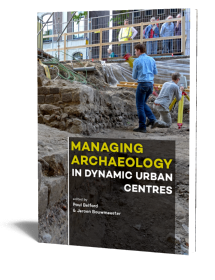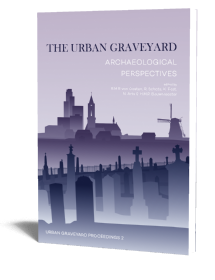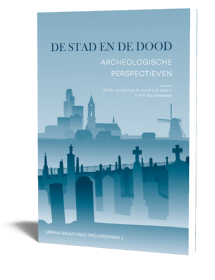Osteoarchaeology in historical context
Cemetery research from the Low Countries
Edited by Roos van Oosten, Rachel Schats & Kerry Fast | 2019

Osteoarchaeology in historical context
Cemetery research from the Low Countries
Edited by Roos van Oosten, Rachel Schats & Kerry Fast | 2019
Paperback ISBN: 9789088908330 | Hardback ISBN: 9789088908347 | Imprint: Sidestone Press | Format: 182x257mm | 206 pp. | Urban Graveyard Proceedings 3 | Language: English | 68 illus. (bw) | 26 illus. (fc) | Keywords: urban archaeology; graveyards; cemeteries; osteoarchaeology | download cover
Read online or downloaded 891 times
-
Digital & Online access
This is a full Open Access publication, click below to buy in print, browse, or download for free.
-
Buy via Sidestone (EU & UK)
-
Buy via our Distributors (WORLD)
For non-EU or UK destinations you can buy our books via our international distributors. Although prices may vary this will ensure speedy delivery and reduction in shipping costs or import tax. But you can also order with us directly via the module above.
UK international distributor
USA international distributor
-
Bookinfo
Paperback ISBN: 9789088908330 | Hardback ISBN: 9789088908347 | Imprint: Sidestone Press | Format: 182x257mm | 206 pp. | Urban Graveyard Proceedings 3 | Language: English | 68 illus. (bw) | 26 illus. (fc) | Keywords: urban archaeology; graveyards; cemeteries; osteoarchaeology | download cover
Read online or downloaded 891 times

We will plant a tree for each order containing a paperback or hardback book via OneTreePlanted.org.
Osteoarchaeology is a rich field for reconstructing past lives in that it can provide details on sex, age-at-death, stature, and pathology in conjunction with the cultural, social, and economic aspects of the person’s environment and burial conditions. While osteoarchaeological research is common in the Low Countries, many of the studies done on the excellent skeletal collections remain unpublished and therefore unavailable to a larger audience.
Following on the Urban Graveyards volumes, Osteoarchaeology in historical context contributes to the dissemination of cemetery research in the Low Countries. Several important skeletal collections are examined in their historical contexts to better understand past living and dying. Osteoarchaeological data are combined with information on burial location, orientation, and grave goods. In doing so, this volume expands our knowledge of contextual cemetery research in the Low Countries and serves as a starting point for comparative research.
Immigrants in Vlaardingen. Archaeological research at a cemetery dated c 1000-1050
Tim de Ridder
Digging up the dead in Eindhoven: The choir and churchyard of St. Catharine’s, 1200-1850
Nico Arts
The monastic cemetery of the Broederenkerk in Zutphen: For monks only?
Steffen Baetsen & Michel Groothedde
In sickness and in health: An archaeological and osteoarchaeological analysis of St. Gertrude’s infirmary in Kampen (1382–c. 1611)
Rachel Schats & Michael Klomp
Diversity in death: skeletal evidence of burial preferences in a late to post-medieval convent in Aalst (Belgium)
Jessica L.A Palmer
Taking sides: an osteoarchaeological analysis of human skeletal remains from the south and north sides of St. Andrew’s Church (Andreaskerk) in Hattem, the Netherlands.
Barbara Veselka & Michael Klomp
The cursed side: A folk belief evidenced by documentary records in ‘s-Hertogenbosch (1782–1858)
Roos van Oosten
Methods of ageing and sexing human dry bone put to the test Looking back on the 1987-1988 excavations in the Broerenkerk in Zwolle
Nico Aten & Hemmy Clevis

Dr. Roos van Oosten
Roos van Oosten is universitair docent stadsarcheologie aan de Universiteit Leiden. Naast het verzorgen van onderwijs verricht zij momenteel onderzoek in het kader van haar Veni-project ‘Challenging the paradigm of filthy and unhealthy medieval towns’.
—
Roos van Oosten began her academic career studying medieval history after which she began her archaeological degree that culminated in a thesis on urban archaeology. Her PhD dissertation at the University of Groningen focused on sanitation management, which she successfully defended in 2014. In 2011 she was appointed as university lecturer in urban archaeology at Leiden University.

Dr. Rachel Schats
Rachel Schats is gepromoveerd op het onderzoek naar de fysieke consequenties van de middeleeuwse ontwikkelingen aan de hand van verschillende rurale en urbane skeletcollecties. Op het moment is zij werkzaam aan Universiteit Leiden als docent waar ze verantwoordelijk is voor het osteoarcheologische onderwijs in de bachelor en master.
—
Rachel Schats studied archaeology with a specialisation in osteoarchaeology at Leiden University and University College London after which she was appointed as a research and teaching assistant for the Laboratory of Human Osteoarchaeology in Leiden. Her PhD (defended November 2016) aimed at gaining a better understanding of the physical consequences of medieval developments, such as urbanisation and commercialisation, by comparing rural and urban skeletal populations.

Dr. Kerry Fast
Kerry Fast holds a PhD from the Centre for the Study of Religion at the University of Toronto. Her doctoral research was a historical-anthropological study of Canadian women’s religious lives. In more recent years, she has focused her research attention on traditional, distinct Mennonite groups, which has taken her to Bolivia, Mexico, and across Canada where she has conducted ethnographic research in Mennonite communities.
Abstract:
Osteoarchaeology is a rich field for reconstructing past lives in that it can provide details on sex, age-at-death, stature, and pathology in conjunction with the cultural, social, and economic aspects of the person’s environment and burial conditions. While osteoarchaeological research is common in the Low Countries, many of the studies done on the excellent skeletal collections remain unpublished and therefore unavailable to a larger audience.
Following on the Urban Graveyards volumes, Osteoarchaeology in historical context contributes to the dissemination of cemetery research in the Low Countries. Several important skeletal collections are examined in their historical contexts to better understand past living and dying. Osteoarchaeological data are combined with information on burial location, orientation, and grave goods. In doing so, this volume expands our knowledge of contextual cemetery research in the Low Countries and serves as a starting point for comparative research.
Contents
Immigrants in Vlaardingen. Archaeological research at a cemetery dated c 1000-1050
Tim de Ridder
Digging up the dead in Eindhoven: The choir and churchyard of St. Catharine’s, 1200-1850
Nico Arts
The monastic cemetery of the Broederenkerk in Zutphen: For monks only?
Steffen Baetsen & Michel Groothedde
In sickness and in health: An archaeological and osteoarchaeological analysis of St. Gertrude’s infirmary in Kampen (1382–c. 1611)
Rachel Schats & Michael Klomp
Diversity in death: skeletal evidence of burial preferences in a late to post-medieval convent in Aalst (Belgium)
Jessica L.A Palmer
Taking sides: an osteoarchaeological analysis of human skeletal remains from the south and north sides of St. Andrew’s Church (Andreaskerk) in Hattem, the Netherlands.
Barbara Veselka & Michael Klomp
The cursed side: A folk belief evidenced by documentary records in ‘s-Hertogenbosch (1782–1858)
Roos van Oosten
Methods of ageing and sexing human dry bone put to the test Looking back on the 1987-1988 excavations in the Broerenkerk in Zwolle
Nico Aten & Hemmy Clevis

Dr. Roos van Oosten
Roos van Oosten is universitair docent stadsarcheologie aan de Universiteit Leiden. Naast het verzorgen van onderwijs verricht zij momenteel onderzoek in het kader van haar Veni-project ‘Challenging the paradigm of filthy and unhealthy medieval towns’.
—
Roos van Oosten began her academic career studying medieval history after which she began her archaeological degree that culminated in a thesis on urban archaeology. Her PhD dissertation at the University of Groningen focused on sanitation management, which she successfully defended in 2014. In 2011 she was appointed as university lecturer in urban archaeology at Leiden University.

Dr. Rachel Schats
Rachel Schats is gepromoveerd op het onderzoek naar de fysieke consequenties van de middeleeuwse ontwikkelingen aan de hand van verschillende rurale en urbane skeletcollecties. Op het moment is zij werkzaam aan Universiteit Leiden als docent waar ze verantwoordelijk is voor het osteoarcheologische onderwijs in de bachelor en master.
—
Rachel Schats studied archaeology with a specialisation in osteoarchaeology at Leiden University and University College London after which she was appointed as a research and teaching assistant for the Laboratory of Human Osteoarchaeology in Leiden. Her PhD (defended November 2016) aimed at gaining a better understanding of the physical consequences of medieval developments, such as urbanisation and commercialisation, by comparing rural and urban skeletal populations.

Dr. Kerry Fast
Kerry Fast holds a PhD from the Centre for the Study of Religion at the University of Toronto. Her doctoral research was a historical-anthropological study of Canadian women’s religious lives. In more recent years, she has focused her research attention on traditional, distinct Mennonite groups, which has taken her to Bolivia, Mexico, and across Canada where she has conducted ethnographic research in Mennonite communities.
-
Digital & Online access
This is a full Open Access publication, click below to buy in print, browse, or download for free.
-
Buy via Sidestone (EU & UK)
-
Buy via our Distributors (WORLD)
For non-EU or UK destinations you can buy our books via our international distributors. Although prices may vary this will ensure speedy delivery and reduction in shipping costs or import tax. But you can also order with us directly via the module above.
UK international distributor
USA international distributor
- Browse all books by subject
-
Search all books

We will plant a tree for each order containing a paperback or hardback book via OneTreePlanted.org.
You might also like:
© 2025 Sidestone Press KvK nr. 28114891 Privacy policy Sidestone Newsletter Terms and Conditions (Dutch)








